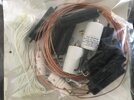As long as you only use it for Rxing and not Txing, I have found it worthwhile to keep a roll of 24AWG wire
Nothing wrong with it for TX either as long as you can support it mechanically. I did a Worked All States in 1 yr with thin magnet wire stuck to the ceiling of a cinder block and slab studio apartment on 15/20 M. Certainly not ideal but with time on the air, good band conditions and CW it worked.
I was a college student at the time and I used what I had at hand, but yep, it's easy to do better than what I did with better materials that are not so mechanically fragile (and lossy at RF)
Johnny; Congrats on the license and getting on the air. You picked the VERY BEST time in the 11 year cycle to get on 10M. Antennas are really practical and fun things to experiment with. There's nothing like using what you have built to get a real feeling of achievement. You can add a passive wire reflector element and aim the resulting array about 20 degrees East of North and pick up about 4db of gain in that direction !
The 7300 is a great rig. The amount of radio one can purchase these days for relatively short money is really amazing. I've not bought a contemporary rig (other than a few dozen vintage HF radios) since my TenTec Omni VI+ 20 plus years ago, and I'm about to take the plunge and get a FTDX101D. I operated a friends FTDX 10 and it has a really great receiver.
Have you set up Logbook of the World (LOTW) yet? It's handy since you're working dx now.
No, you're not wasting your time without an antenna analyzer (though they're handy!). Hams did without for decades. As far as what to try next, you could do a fan dipole, and just attach other dipoles to the feedpoint of the antenna you have built already, cut the the appropriate length with the far ends separated by a foot or so. This starts to get to be a mechanical challenge (as all antenna projects do) but a trip to the pvc pipe section of Lowes will get you set up with suitable insulating materials. A calculator and a SWR bridge will serve.
JW: The nano VNA is really useful (even though I'm really slow using it). I built a notch filter to null out the AM BCB on my Kiwi SDR since I have a station about 1 mile from me, and the ability of the Nano to instantly evaluate the filter performance was really handy. There's still some bleed though but not nearly like it was before. The ability to instantly measure the design was great (about resulted in 50-60dB of attenuation in the notch)

Last edited:




